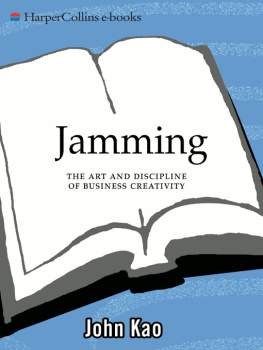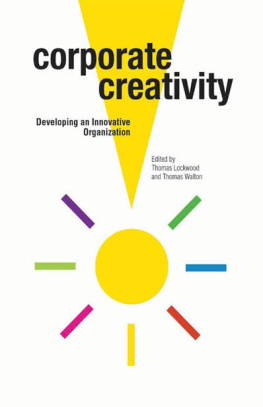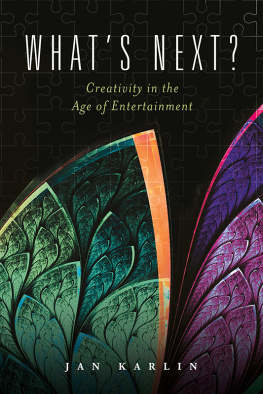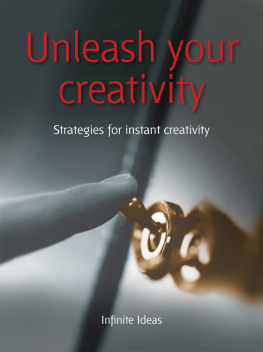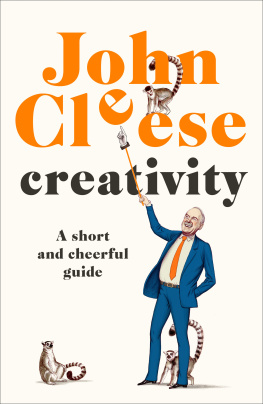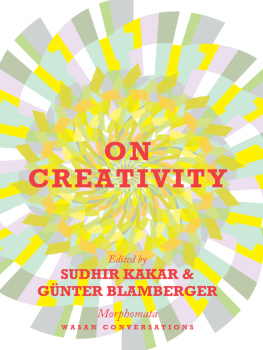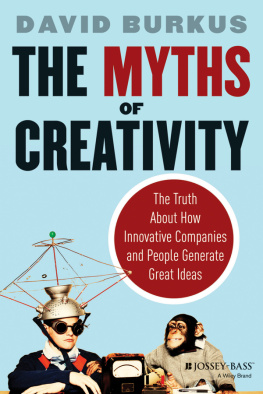jam to improvise on a musical instrument with a group: take part in a jam session (gathered after hours with their instruments and jammed all night)
Websters Third New International Dictionary
jam to take a theme, a question, a notion, a whim, an idea, pass it around, break it up, put it together, turn it over, run it backward, fly with it as far as possible, out of sight, never retreatingbut yes, here it comes, homing in, changed, new, the essence, like nothing ever before
Jamming
The Art and Discipline of Business Creativity
A dozen years ago, when I said I wanted to teach a course on the art and discipline of creativity at the Harvard Business School, a distinguished colleague laughed at the idea. There was nothing new to teach about creativity, he told me, and, in any event, MBA students and corporate executives wouldnt be interested.
Well, things have changed, and no ones laughing now. The elective course I introduced in 1983 has attracted some two thousand second-year MBA students, and my executive seminars on creativity draw top executives from companies such as AT&T Corporation, Merck & Company, and Merrill Lynch & Company. Students of business and senior executives alike arent just interested in creativity, theyre fascinated by itand with good reason. For managers, the nurture and promotion of creativity is no longer an elective. Its part of the required curriculum.
In todays new economynonprofit as well as for-profitthe minds of gifted people are what truly distinguish one organization from another, whether it be a software outfit, a tool-and-die shop in the renascent rust belt, an arts foundation, a messenger service in Manhattan, a town government, or a truck manufacturer in Detroit. But minds alone, however prolific with fresh ideas, are nothing without processes specifically designed to translate these fresh ideas into valued products and services.
I know: In many businesspeoples lexicon, creativity is right up there with nice in the mushy-word category. Such people had better revise their lexicons. The truth is, creativity is hard work, as almost every creative person will confirm. The great sports writer Red Smith once said, Sure, writing is easy, you just sit down at the typewriter and open a vein. And managing creativity is, if anything, even harder work. It has nothing to do with finding a nice safe place for people to goof off. Managing creativity is much more difficult. It means finding an appropriate place for people to contend and collaborateeven if they dont particularly want to. It means scrounging from always-limited resources. It means controlling an uncontrollable, or at least unpredictable, process. Creativity, for many, is a blood sport.
Is that still too mushy for you? Consider this: Hardly a day goes by without creativity being evaluated in the toughest, most unambiguous terms we knowmoney. For example, when entertainment moguls Steven Spielberg, David Geffen, and Jeffrey Katzenberg formed DreamWorks SKG, they announced that they would sell a one-third stake in their brand-new company for $900 million. You dont have to be a financial wizard to infer that the founders valued their new venture at $2.7 billion, suggesting that they valued their own equity position at $1.8 billion. Not bad for a startup with rented offices, leases on the copying machines, and little if anything in the way of traditional tangible assets.
So whats the significance of the premium we put on creativity? You wont find much help under Generally Accepted Accounting Principles, thats for sure. But creativity is valuable even so. Of course, many people do expect media and high-tech companies to assign a dollar-and-cents value to their own creativity. But wise investors should demand to know the dollar-and-cents value of creativity even in companies that sell socks, boilers, stationery, or plumbing fixtures, or deliver accounting, dog-training, logistics, or diagnostic services. After all, the success of the products or services of any enterprise depends on the creativityor lack of itthat went into them.
Take heed of the words of people who have reason and experience to know the importance of creativity:
- Leon Royer, executive director, Minnesota Mining and Manufacturing Company (3M), asserts, Either youll learn to acquire and cultivate [creative people] or youll be eaten alive.
- Southwood J. Morcott, CEO, Dana Corporation, knows that the only way to improve your margins today is by improving your product. How to do that? Through our ideas generation program, we expect people to have two new ideas each month. And we expect management to inplement 80% of these ideas. We believe in People Finding a Better Way.
- Jack Welch, CEO, General Electric Company, says, My job is to listen to, search for, think of, and spread ideas, to expose people to good ideas and role modelsWhen self-confident people see a good idea, they love it.
- Marsh Fisher, cofounder, Century 21 Real Estate Corporation, says, The real true source of power in any company today is ideasthe rest is housekeeping. Ideas are the DNA of everything that is worthwhile.
- Bob Lutz, CEO, Chrysler Corporation, talks about the surprising success of its car model, the Neon: For too many years, it was said that Americans cant innovate. That is changing everywhere in Detroit, and it is definitely changing at Chrysler.
- Marv Patterson, former director of corporate engineering, Hewlett-Packard Company, says that for HP the first step in the creativity process is hiring the best of the best. This is how HP maintains an environment that crackles with creativity and intellectual spirit.
- Michael Fradette, manufacturing consultant, Deloitte & Touche, asserts, To make money in a disinflationary period takes real innovation and creativity at all levels of the corporation.
- Paul Otellini, senior vice president, Intel Corporation, believes that Intels history is to obsolete its old products with its next products.
- Lloyd Cotsen, CEO of Neutrogena Corporation, states that managing creativity is the essence of the CEOs job.
- Lawrence Wilkinson, president of the Global Business Network, feels that ability to improvise will be the key business skill of the coming decade.
Im well aware that everything Ive said begs an enormous question. Okay, you say, creativity is in, creativity is a must, creativity is the way to go. But how do I get some of that good stuff for my company? For me? How do I make it happen?
In my courses I offer tough, practical answers to those questions. I show managers and future managers precisely how they can mobilize the creativity advantage by engaging their employees minds, stimulating their imaginations, and organizing their processes, and how, by giving people the opportunity to use their talents, they can assure their loyalty. Those managerial skills pertain to every aspect of every business enterprise.
In this book, I venturemuch further than I can within the boundaries of a courseto present a new vision of managers running their companies, divisions, teams, and relationships in ways that bring creativity to the forefront and multiply its benefits throughout the enterprise.
I define creativity as the entire process by which ideas are generated, developed, and transformed into value. It encompasses what people commonly mean by innovation and entrepreneurship. In our lexicon, it connotes both the art of giving birth to new ideas and the discipline of shaping and developing those ideas to the stage of realized value.

